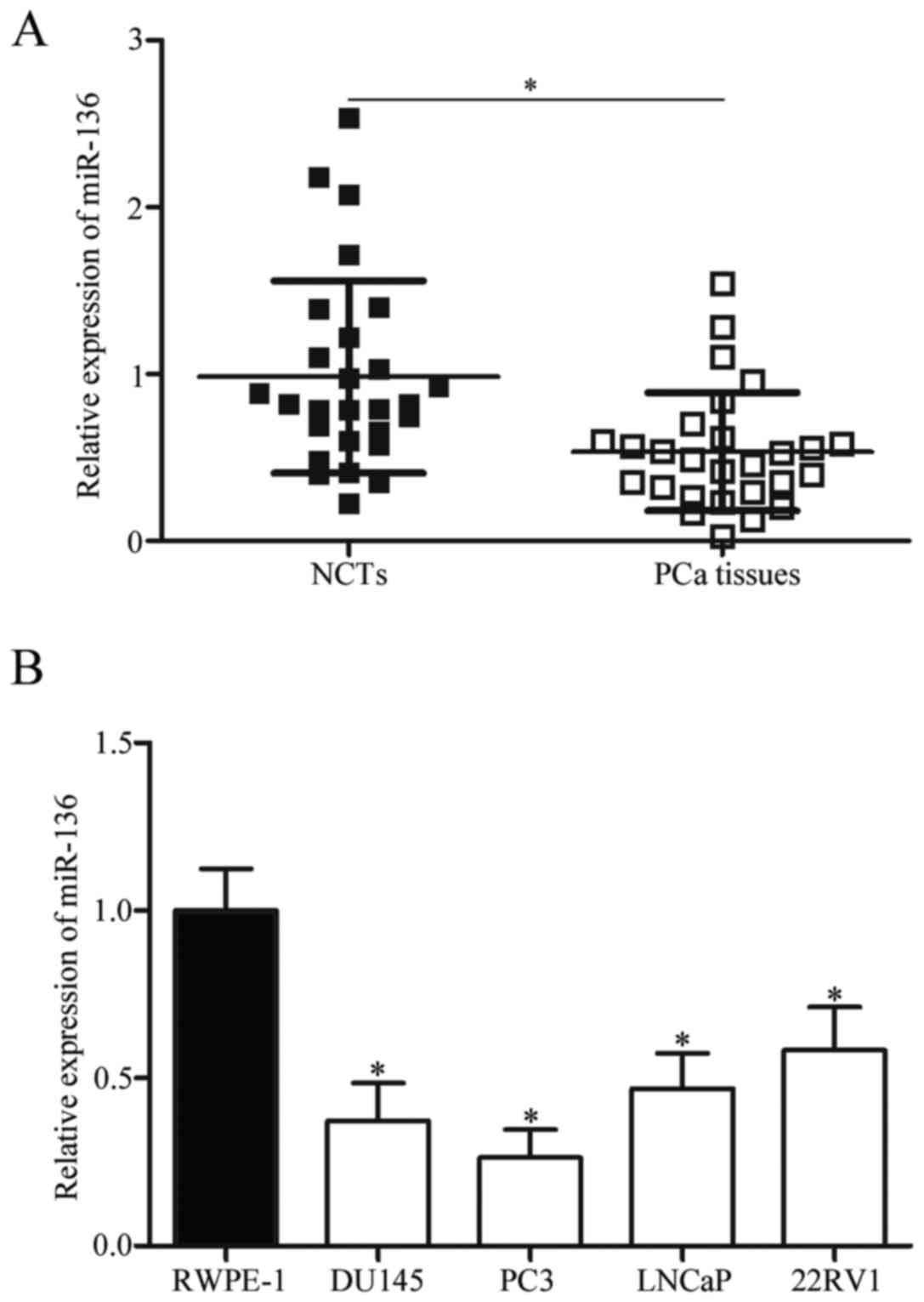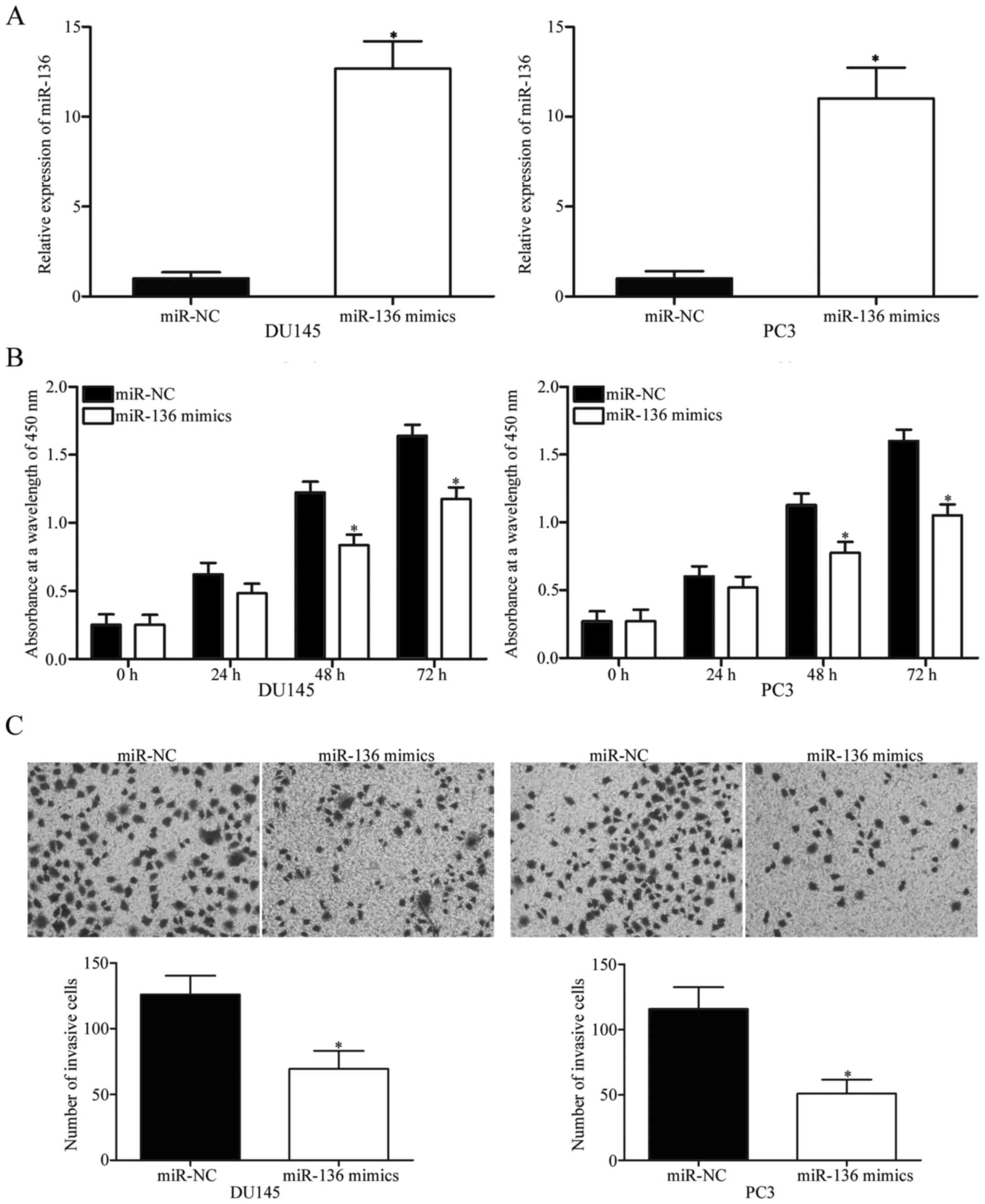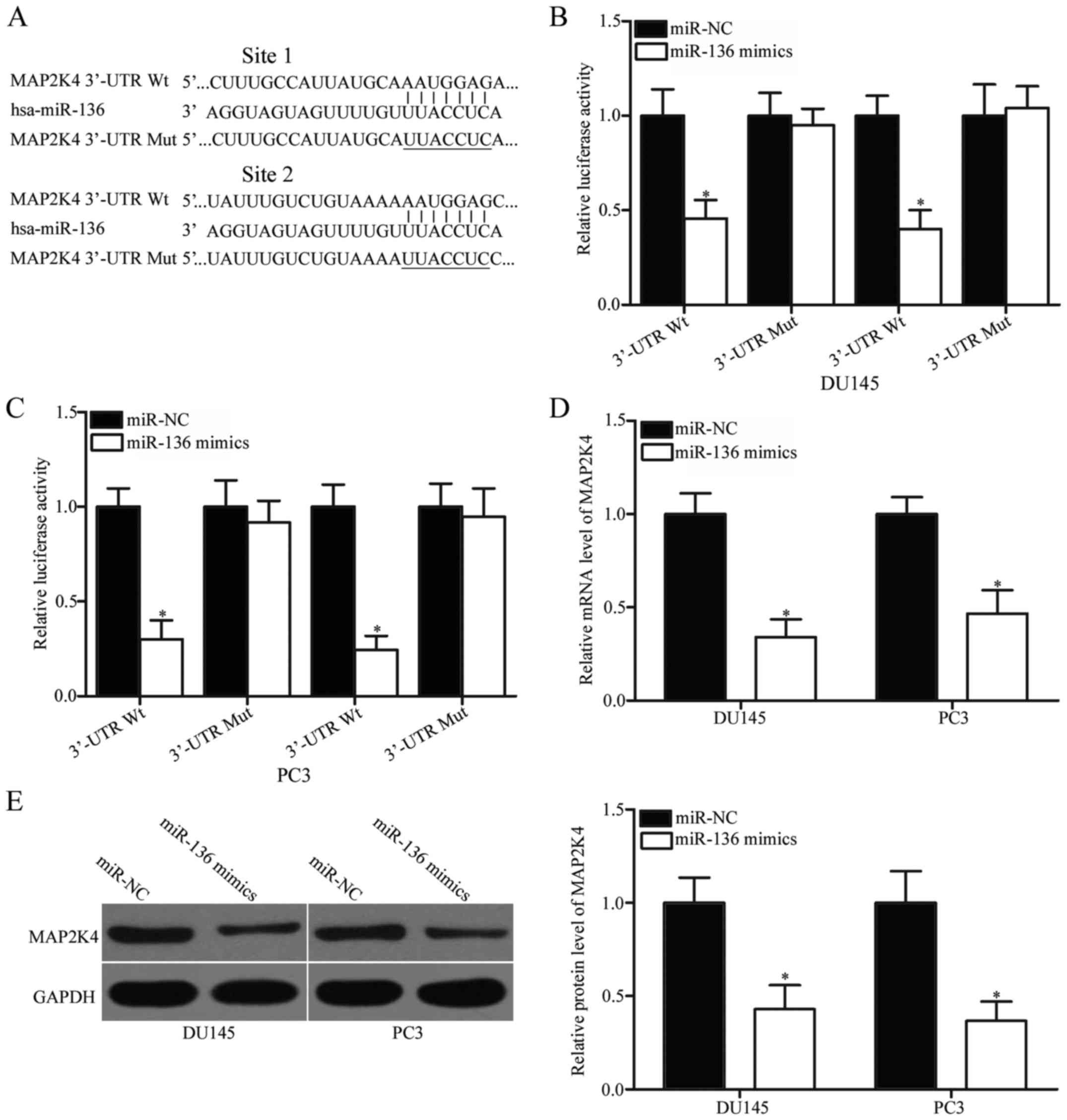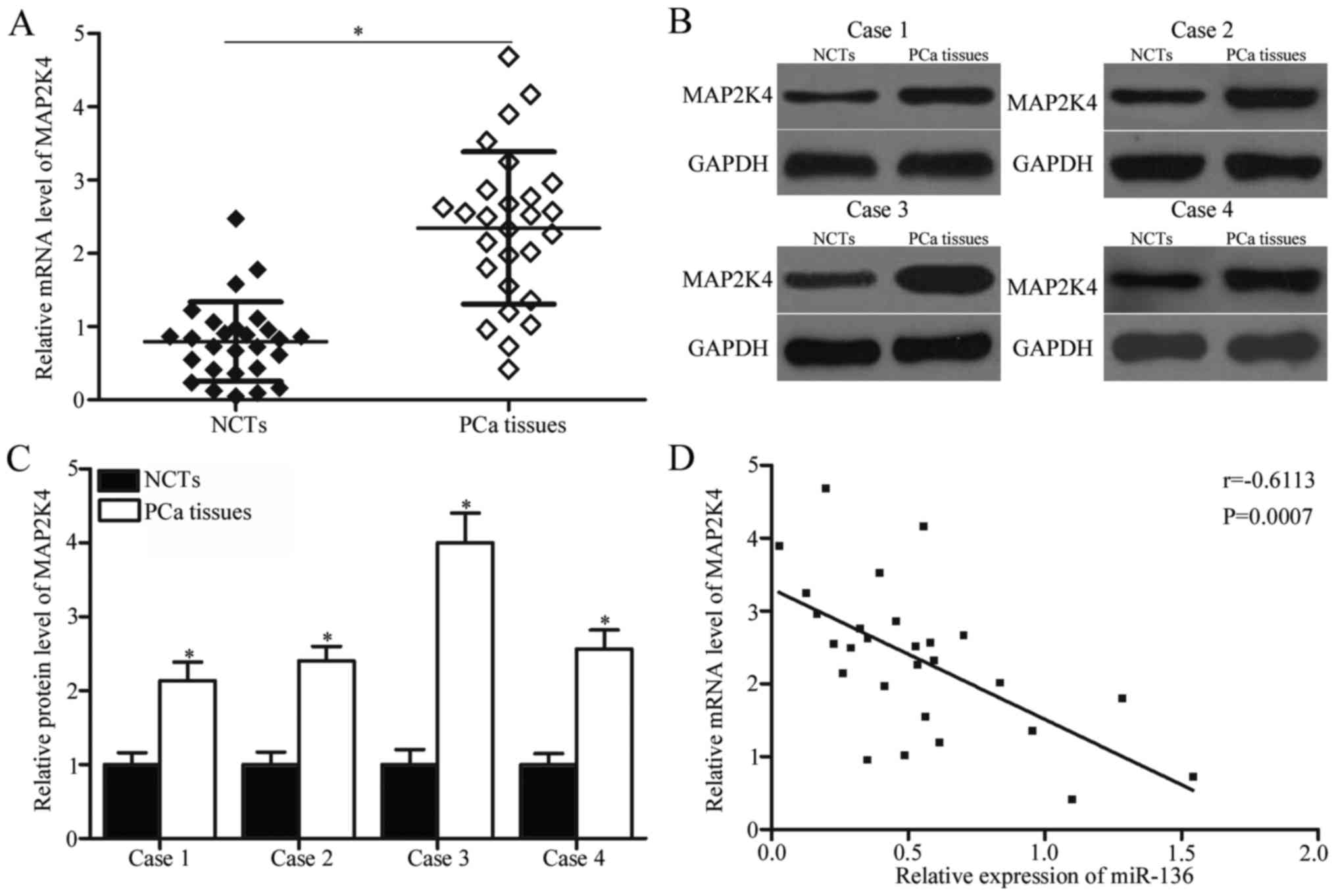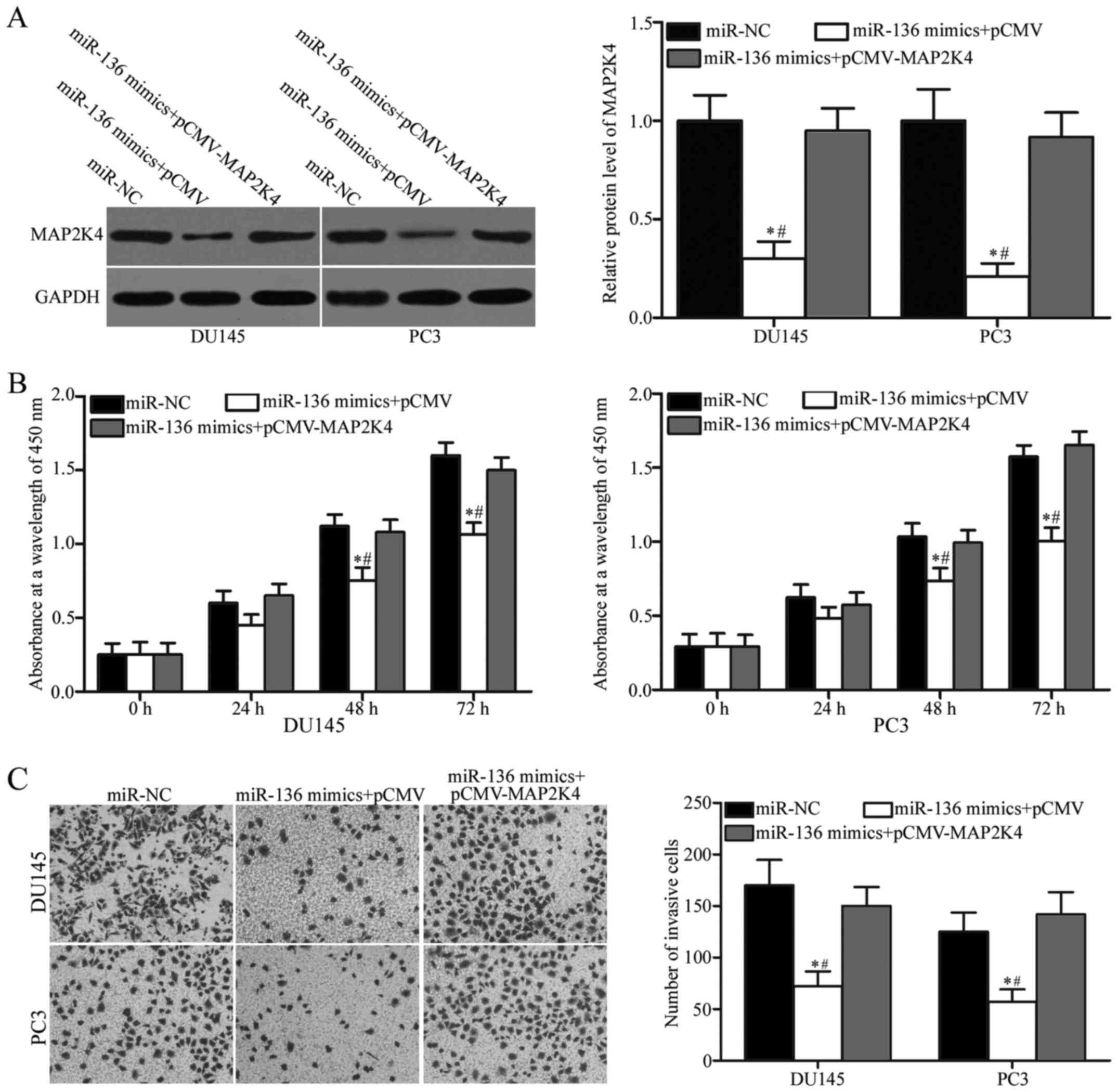MicroRNA‑136 inhibits prostate cancer cell proliferation and invasion by directly targeting mitogen‑activated protein kinase kinase 4
Retraction in: /10.3892/mmr.2023.13003
- Authors:
- Published online on: January 10, 2018 https://doi.org/10.3892/mmr.2018.8417
- Pages: 4803-4810
Abstract
Introduction
Prostate cancer (PCa), a highly common malignant tumour in the urinary and reproductive systems, is the second most common cancer and the sixth leading cause of cancer-related deaths worldwide (1,2). In recent years, the incidence and mortality of PCa in China have gradually increased with progressing economy (3). Despite the unclear aetiology of this malignancy, both hereditary and environmental components have been demonstrated to participate in prostate carcinogenesis, where age, race and family history are the only well-established risk factors (4,5). Over the past decades, considerable advances have been achieved in the diagnosis and treatment of PCa. However, the long-term survival of patients with PCa remains poor (6). The 5-year relative survival rate of patients with PCa at the advanced metastatic stage is only 28% (7). The local or distant metastasis, recurrence and development of hormone refractory disease remain the major causes of death (8,9). Therefore, the molecular mechanisms underlying the formation and progression of PCa must be elucidated to develop novel and effective therapeutic methods for treatment of patients with this malignancy.
MicroRNAs (miRNAs) are a subset of non-coding, single-stranded, short RNA molecules that are 19–24 nucleotides in length (10). miRNAs regulate gene expression primarily by binding to the 3′-untranslated regions (3′-UTRs) of their target genes in a sequence-dependent recognition manner, thereby inducing mRNA degradation or blocking the translation of the encoded protein (11). At least one-third of human genes are estimated to be regulated by miRNAs, which serve key roles in numerous biological processes, such as differentiation, organ development, immune responses, proliferation, apoptosis and signal transduction (12). Several lines of evidence suggest that miRNAs are aberrantly expressed in almost all types of human cancer, including PCa (13,14). miRNAs act as either oncogene or tumour suppressor due to the different cellular contexts of malignancies (15,16). miRNAs also participate in tumourigenesis and tumour development by regulating cell proliferation, cell cycle, cell survival, apoptosis, angiogenesis, cell migration, cell invasion, and metastasis (17). Therefore, investigating cancer-related miRNAs is important to provide novel therapeutic targets for PCa treatment.
miR-136 is significantly decreased in multiple human cancers (18–20). However, limited information is available regarding the expression pattern and biological functions of miR-136 in PCa. Hence, the present study aims to elucidate the expression pattern, biological functions and underlying molecular mechanisms of miR-136 in PCa.
Materials and methods
Clinical specimens
This study was approved by the Ethical Committee of Ningbo No. 2 Hospital. Written informed consent was provided by all patients prior to enrollment in this study. A total of 27 pairs of PCa tissues and adjacent noncancerous tissues (NCTs) were obtained from patients who underwent surgery at Ningbo No. 2 Hospital from June 2014 to February 2016. None patients had been treated with any treatment including chemotherapy, radiotherapy and androgen-deprivation treatment before surgery. Following surgical resection, all tissues were immediately frozen in liquid nitrogen and stored at −80°C until further use.
Cell culture and transfection
Human PCa cells (DU145, PC3, LNCaP and 22RV1) and normal prostatic epithelial cell line (RWPE-1) were acquired from Institute of Biochemistry and Cell Biology at the Chinese Academy of Sciences (Shanghai, China). All PCa cell lines were cultured in RPMI-1640 medium with 10% fetal bovine serum (FBS), 100 U/ml penicillin and 100 µg/ml streptomycin (all from Gibco, Grand Island, NY, USA). RWPE-1 cells were grown in keratinocyte-serum-free medium containing 50 mg/ml bovine pituitary extract and 5 ng/ml recombinant human epidermal growth factor (all from Invitrogen; Thermo Fisher Scientific, Inc., Waltham, MA, USA). All cell lines were maintained at 37°C in a humidified atmosphere of 5% CO2 and 95% air.
miR-136 mimics and negative control miRNA mimics (miR-NC) were purchased from GenePharma Co., Ltd. (Shanghai, China). MAP2K4 overexpression plasmid (pCMV-MAP2K4) and blank plasmid pCMV were chemically synthesized by Guangzhou RiboBio Co., Ltd. (Guangzhou, China). For transfection, cells were plated in 6-well plates 24 h prior to transfection. Cell transfection was carried out using Lipofectamine 2000 (Invitrogen Life Technologies, Carlsbad, CA, USA) according to the manufacturer's instructions.
Reverse transcription-quantitative polymerase chain reaction (RT-qPCR)
Total RNA was isolated from tissues or cells using TRIzol reagent (Thermo Fisher Scientific, Inc.) in accordance with the manufacturer's instructions. A NanoDrop 2000 (Thermo Fisher Scientific, Inc., Wilmington, DE, USA) was used to determine the RNA purity and concentration. To quantify miR-136 expression, the complementary DNA (cDNA) was synthesized using the TaqMan MicroRNA Reverse Transcription kit and the quantitative PCR was performed using the TaqMan MicroRNA PCR kit (both from Applied Biosystems, Foster City, CA, USA). U6 snRNA used as an control for miR-136 expression. For detection of MAP2K4 mRNA, a PrimeScript RT Reagent kit (Takara Biotechnology, Co., Ltd., Dalian, China) was utilized to synthesize the cDNA. The PCR amplification for the quantification of MAP2K4 mRNA was carried out using the SYBR Premix Ex Taq™ kit (Takara Biotechnology, Co., Ltd.). The relative expression of MAP2K4 mRNA was illustrated as fold difference relative to GAPDH. Relative expression was analyzed using the 2−ΔΔCq method (21).
Cell Counting Kit-8 (CCK-8) assay
PCa cell proliferation was detected by the CCK-8 assay in accordance with the manufacturer's instructions. Transfected cells were collected 24 h post-transfection. For the CCK-8 assay, cells were seeded in 96-well plates at a density of 3×103 cells/well. The CCK-8 assay was performed at 0, 24, 48, 72 and 96 h after incubation. In brief, 10 µl of the CCK-8 reagent (Dojindo Laboratories, Kumamoto, Japan) was added, and the plate was incubated at 37°C with 5% CO2 for 2 h. Absorbance at 450 nm wavelength was recorded on a multilabel plate reader (BioTek Instruments, Inc., Winooski, VT, USA). Each assay was performed in triplicate and repeated three times.
Matrigel invasion assay
The invasion ability of PCa cells was examined using Transwell chambers (EMD Millipore, Billerica, MA, USA) coated with Matrigel (BD Biosciences, San Jose, CA, USA). The transfected cells were harvested 48 h post-transfection by using 0.2% trypsin/EDTA solution (Gibco) and washed with fetal bovine serum (FBS)-free RPMI-1640 medium. A total of 5×104 transfected cells in FBS-free RPMI-1640 medium were added to the upper chamber. RPMI-1640 medium supplemented with 10% FBS was then added to the lower chamber to serve as chemoattractant. After incubation at 37°C with 5% CO2 for 24 h, the cells attached to the upper surface of the chamber were removed by a cotton swab. The invasive cells were fixed with 100% methanol and stained with 0.5% crystal violet solution (Beyotime Institute of Biotechnology, Haimen, China). The invasive cells were then photographed and counted in five randomly selected fields under an inverted microscope (×200; Olympus, Tokyo, Japan).
Bioinformatics analysis
Potential target genes for miR-136 were predicted using (http://www.targetscan.org/index.html) and miRanda (http://www.microrna.org/microrna/).
Luciferase reporter assay
For luciferase reporter assay, the luciferase plasmids, pmirGLO-MAP2K4-3′-UTR wild-type (Wt1 and 2) and pmirGLO-MAP2K4-3′-UTR mutant (Mut1 and 2), were chemically synthesized and confirmed by GenePharma Co., Ltd. Cells were seeded into 24-well plates at a density of 1.5×105 cells each well and cultured at 37°C with 5% CO2 for 24 h. miR-136 mimics or miR-NC was transfected into cells, together with pmirGLO-MAP2K4-3′-UTR Wt (1 and 2) or pmirGLO-MAP2K4-3′-UTR Mut (1 and 2), using Lipofectamine 2000 according to the manufacturer's instructions. At 24 h post-transfection, luciferase activities were measured by using a Dual-Luciferase Reporter Assay system (Promega, Madison, WI, USA), according to the manufacturer's instructions. Renilla luciferase activity was used as an internal control.
Western blot analysis
Total protein was extracted from tissues or cells using RIPA lysis buffer (Beyotime Institute of Biotechnology, Jiangsu, China). After centrifugation at 12,000 × g for 15 min at 4°C, a BCA Protein Assay kit (Beyotime Institute of Biotechnology) was adopted to detect the protein concentration. Equal amounts of protein was loaded on a 10% sodium dodecyl sulfate-polyacrylamide gel and transferred to polyvinylidene difluoride membranes (EMD Millipore). After blocking with 5% non-fat dry milk in Tris-buffered saline containing 0.05% Tween-20 (TBST) at room temperature for 2 h, the membranes were incubated at 4°C overnight with primary antibodies: Mouse anti-human MAP2K4 monoclonal antibody (sc-136314, 1:1,000 dilution) or mouse anti-human GAPDH monoclonal antibody (sc-47724, 1:1,000 dilution) (both from Santa Cruz Biotechnology, Inc., Santa Cruz, CA, USA). Afterwards, the membranes were washed with TBST for three times and probed with goat-anti mouse horseradish peroxidase-conjugated secondary antibody (sc-2005, 1:5,000 dilution; Santa Cruz Biotechnology, Inc.) at room temperature for 1 h. Finally, the proteins were visualized using ECL Immunoblot Detection system (Pierce, Rockford, IL, USA). Densitometry of protein bands was quantified with Quantity One software (Bio-Rad Laboratories, Inc., Hercules, CA, USA). GAPDH served as a loading control.
Statistical analysis
Data are presented as the median ± standard deviation, and analyzed using SPSS software (version 20.0; SPSS Inc., Chicago, IL, USA). Differences between groups were analyzed using student's t-test or one-way ANOVA with a Student-Newman-Keuls post hoc test. The association between miR-136 and MAP2K4 expression levels was determined using Spearman's correlation analysis. P<0.05 were considered to indicate a statistically significant difference.
Results
miR-136 is downregulated in PCa tissues and cell lines
To investigate the expression pattern of miR-136 in PCa, we firstly measured the expression level of miR-136 in 27 pairs of PCa tissues and NCTs. Results showed that miR-136 expression was downregulated in PCa tissues than in NCTs (Fig. 1A; P<0.05). In addition, miR-136 expression was detected in four PCa cell lines (DU145, PC3, LNCaP and 22RV1) and a normal prostatic epithelial cell line (RWPE-1). The expression level of miR-136 was lower in all examined PCa cell lines than in RWPE-1 (Fig. 1B; P<0.05). These results suggested that the decreased expression of miR-136 was likely associated with PCa progression.
miR-136 overexpression inhibits cell proliferation and invasion in PCa
To evaluate the biological roles of miR-136 in PCa, we transfected DU145 and PC3 cells, which were expressed relatively lower miR-136 levels, with miR-136 mimics to increase miR-136 expression levels. After transfection, RT-qPCR confirmed that transfection with miR-136 mimics significantly increases the miR-136 levels relative to those of the cells transfected with miR-NC (Fig. 2A; P<0.05). Subsequently, CCK-8 assay was performed to investigate the effect of miR-136 overexpression on PCa cell proliferation. Results revealed that upregulating miR-136 significantly decreases the growth rate relative to that in the miR-NC-transfected DU145 and PC3 cells at 48 and 72 h after plating (Fig. 2B; P<0.05). We also examined the effect of miR-136 on cell invasion ability by using a Matrigel invasion assay. The ectopic expression of miR-136 decreased the invasion capacities of both DU145 and PC3 cells relative to those in the miR-NC group (Fig. 2C; P<0.05). These results suggest that miR-136 is involved in regulating PCa progression and may serve as a tumour suppressor.
MAP2K4 is a direct target of miR-136 in PCa
To study the mechanism underlying the tumour-suppressive roles of miR-136 in PCa, we conducted bioinformatics analysis to predict the potential targets of the miRNA. MAP2K4, which is highly expressed in PCa and contributes to PCa occurrence and development (22–24), has been predicted as a major target of miR-136 and selected for further confirmation. The 3′-UTR of MAP2K4 contains two predicted binding sites for miR-136 (Fig. 3A). To determine whether miR-136 can directly interact with the 3′-UTR of MAP2K4, we conducted a luciferase reporter assay. Results showed that miR-136 overexpression significantly repressed the activity of the MAP2K4-3′-UTR luciferase plasmid containing a wild-type gene (1 and 2; Fig. 3B and C; P<0.05). By contrast, no change in luciferase activity was observed when the miR-136 binding site was mutated (1 and 2). This observation indicates that miR-136 directly interacted with the two target regions in the 3′-UTR of MAP2K4. RT-qPCR and western blotting were performed to illustrate that miR-136 can regulate the endogenous expression of MAP2K4. Our data showed that the enforced expression of miR-136 reduced the MAP2K4 expression in DU145 and PC3 cells at the mRNA (Fig. 3D; P<0.05) and protein (Fig. 3E; P<0.05) levels. These findings suggest that MAP2K4 is a direct target of miR-136 in PCa.
Increased MAP2K4 levels are inversely associated with miR-136 expression in PCa tissues
To further explore the relationship between miR-136 and MAP2K4 in PCa, we detected MAP2K4 expression levels in PCa tissues and NCTs. RT-qPCR results indicated that MAP2K4 mRNA expression was significantly increased in the PCa tissues than in the NCTs (Fig. 4A; P<0.05). In addition, the protein expression level of MAP2K4 was examined in four randomly selected paired PCa tissues and NCTs. The data of western blotting revealed that protein level of MAP2K4 was higher in the PCa tissues than in the NCTs (Fig. 4B and C; P<0.05). A negative correlation was observed between miR-136 and MAP2K4 mRNA expression in PCa tissues (Fig. 4D; r=−0.6113, P=0.0007). This negative correlation suggests that the upregulation of MAP2K4 in PCa may partially be due to the downregulation of miR-136.
MAP2K4 overexpression reverses miR-136 inhibitory effects on the cell proliferation and invasion of PCa
To investigate whether miR-136 exerts its tumour suppressive roles in PCa by regulating MAP2K4, we carried out a rescue experiment involving DU145 and PC3 cells cotransfected with miR-136 mimics and pCMV or pCMV-MAP2K4. After transfection, Western blotting analysis revealed that the reduced expression of MAP2K4 induced by miR-136 mimics can be significantly recovered by cotransfection with pCMV-MAP2K4 in DU145 and PC3 cells (Fig. 5A; P<0.05). Subsequently, functional assays showed that restored MAP2K4 expression can reverse the inhibitory effects of miR-136 overexpression on the proliferation (Fig. 5B; P<0.05) and invasion (Fig. 5C; P<0.05) of DU145 and PC3 cells. These results clearly demonstrated that miR-136 can regulate the malignant biological behaviour of PCa cells by inhibiting MAP2K4.
Discussion
Accumulated evidence shows that PCa initiation and progression are controlled by miRNAs (25–27). Therefore, investigating PCa-related miRNAs may provide novel biomarkers for diagnosing and treating the patients with this disease. In the present study, we found that miR-136 was obviously downregulated in PCa tissues and cell lines. Upregulation of miR-136 suppressed the cell proliferation and invasion of PCa. Additionally, MAP2K4 was validated as a direct target of miR-136 in PCa. MAP2K4 was upregulated in PCa tissues, and its expression levels were inversely correlated with those of miR-136. Moreover, restored MAP2K4 expression rescued the miR-136 inhibitory effects on the cell proliferation and invasion of PCa. Therefore, our present data suggest that miR-136 is a brake for the rapid growth and invasion of PCa.
miR-136 dysregulation has been reported in multiple human cancer types. For example, miR-136 was downregulated in gastric cancer tissues and cell lines. Meanwhile, decreased miR-136 expression was significantly associated with increased peritoneal metastasis and worsened prognosis in patients with gastric cancer (18). In triple-negative breast cancer, the expression level of miR-136 is lower in tumour tissues than in normal tissues and negatively correlated with increasing World Health Organisation grades (19). In glioma, miR-136 was mildly expressed and significantly associated with malignancy grade. Log-rank testing indicated that glioma patients with low miR-136 expression exhibited poorer prognosis than those with high miR-136 levels (20). In ovarian cancer, miR-136 expression was decreased in tumour tissues than in the normal control tissues. Low miR-136 expression was associated with poor overall survival in patients with ovarian cancer (28). miR-136 downregulation was observed in colon cancer (29) and melanoma (30). However, in nonsmall-cell lung cancer, miR-136 expression was significantly upregulated in primary tumours and cell lines (31). These conflicting findings suggest that the expression pattern of miR-136 is tissue specific, and this miRNA may be developed as a prognostic marker in cancer.
miR-136 plays tumour-suppressive roles in several tumour types. For instance, Zheng et al found that upregulating miR-136 expression inhibits the peritoneal metastasis of gastric cancer in vitro and in vivo (18). Meanwhile, Yan et al reported that the resumption of expression of miR-136 decreases cell migration and invasion in triple-negative breast cancer (19). Multiple studies showed that miR-136 overexpression promotes cell apoptosis (32), increases chemosensitivity (33) to temozolomide and reverses cisplatin resistance (20) in glioma. Yuan et al revealed that restoring miR-136 expression attenuates cell proliferation and invasion in colon cancer (29). Wang et al indicated that miR-136 overexpression suppresses melanoma cell growth, metastasis, and epithelial-mesenchymal transition as well as induces apoptosis in vitro (30). Jeong et al (28) and Zhao et al (34) demonstrated that enforced miR-136 expression represses cell viability, proliferation, cancer stem cell spheroid formation and angiogenesis; promotes apoptosis; and reduces the chemoresistance to cisplatin in ovarian cancer. Nevertheless, miR-136 plays an oncogenic role in nonsmall-cell lung cancer by regulating anchorage-dependent and -independent proliferation (31). These contradicting findings indicated that miR-136 acts as a tumour suppressor in certain cancers and an oncogene in others.
Several targets of miR-136 have been identified, including HOXC10 in gastric cancer; RASAL2 (19) in breast cancer; E2F1 (20), AEG-1 (32,33) and Bcl-2 in glioma; PPP2R2A (31) in nonsmall-cell lung cancer; LRH-1 (29) in colon cancer; PMEL (30) in melanoma; and Notch3 (28) in ovarian cancer. In the present study, MAP2K4 was demonstrated to be a novel target of miR-136 in PCa. MAP2K4, located on chromosome 17, is a member of the MAPK signalling pathway (35). A large body of evidence has indicated that MAP2K4 is aberrantly expressed in numerous tumours, such as osteosarcoma (36), tongue squamous cell carcinoma (37), breast cancer (38) and pancreatic cancer (39). MAP2K4 is involved in various pathophysiological processes of tumourigenesis and tumour development, including cell proliferation, cycle, apoptosis, invasion and metastasis (36,39–41). In PCa, MAP2K4 is overexpressed in tumour tissues. Increased MAP2K4 expression is correlated with raised pathological stage at prostatectomy (24). Upregulating MAP2K4 promoted cell proliferation and metastasis while inhibiting G1-S phase arrest and cell apoptosis in PCa (22,23). With the emerging correlation of MAP2K4 with aggressive PCa progression, MAP2K4 may be a promising therapeutic target for treating patients with PCa.
In conclusion, the present study proved that miR-136 is downregulated in PCa tissues and cell lines. miR-136 overexpression inhibited PCa cell proliferation and invasion by directly targeting MAP2K4. Our current results demonstrated that using miR-136/MAP2K4-based reagents may be a novel therapeutic approach for patients with PCa.
References
|
Peyromaure EM, Mao K, Sun Y, Xia S, Jiang N, Zhang S, Wang G, Liu Z and Debré B: A comparative study of prostate cancer detection and management in China and in France. Can J Urol. 16:4472–4477. 2009.PubMed/NCBI | |
|
Jemal A, Bray F, Center MM, Ferlay J, Ward E and Forman D: Global cancer statistics. CA Cancer J Clin. 61:69–90. 2011. View Article : Google Scholar : PubMed/NCBI | |
|
Chen W, Zheng R, Baade PD, Zhang S, Zeng H, Bray F, Jemal A, Yu XQ and He J: Cancer statistics in China, 2015. CA Cancer J Clin. 66:115–132. 2016. View Article : Google Scholar : PubMed/NCBI | |
|
Wu D, Zhou Y, Pan H, Qu P and Zhou J: MicroRNA99a inhibits cell proliferation, colony formation ability, migration and invasion by targeting fibroblast growth factor receptor 3 in prostate cancer. Mol Med Rep. 11:1469–1475. 2015. View Article : Google Scholar : PubMed/NCBI | |
|
Rubin MA, Maher CA and Chinnaiyan AM: Common gene rearrangements in prostate cancer. J Clin Oncol. 29:3659–3668. 2011. View Article : Google Scholar : PubMed/NCBI | |
|
Deng X, He G, Liu J, Luo F, Peng X, Tang S, Gao Z, Lin Q, Keller JM, Yang T and Keller ET: Recent advances in bone-targeted therapies of metastatic prostate cancer. Cancer Treat Rev. 40:730–738. 2014. View Article : Google Scholar : PubMed/NCBI | |
|
Siegel RL, Miller KD and Jemal A: Cancer statistics, 2015. CA Cancer J Clin. 65:5–29. 2015. View Article : Google Scholar : PubMed/NCBI | |
|
Souza AG, Bastos VAF, Silva IBB, Marangoni K and Goulart VA: Different gene therapy strategies: A overview for prostate cancer. Curr Gene Ther. 16:287–291. 2016. View Article : Google Scholar : PubMed/NCBI | |
|
Koupparis A and Gleave ME: Multimodal approaches to high-risk prostate cancer. Curr Oncol. 17 Suppl 2:S33–S37. 2010. View Article : Google Scholar : PubMed/NCBI | |
|
Lee YS and Dutta A: MicroRNAs: Small but potent oncogenes or tumor suppressors. Curr Opin Investig Drugs. 7:560–564. 2006.PubMed/NCBI | |
|
Bartel DP: MicroRNAs: Target recognition and regulatory functions. Cell. 136:215–233. 2009. View Article : Google Scholar : PubMed/NCBI | |
|
Krol J, Loedige I and Filipowicz W: The widespread regulation of microRNA biogenesis, function and decay. Nat Rev Genet. 11:597–610. 2010. View Article : Google Scholar : PubMed/NCBI | |
|
Fazi F and Blandino G: MicroRNAs: Non coding pleiotropic factors in development, cancer prevention and treatment. Microrna. 2:812013. View Article : Google Scholar : PubMed/NCBI | |
|
Massillo C, Dalton GN, Farré PL, De Luca P and De Siervi A: Implications of microRNA dysregulation in the development of prostate cancer. Reproduction. 154:R81–R97. 2017. View Article : Google Scholar : PubMed/NCBI | |
|
Volinia S, Calin GA, Liu CG, Ambs S, Cimmino A, Petrocca F, Visone R, Iorio M, Roldo C, Ferracin M, et al: A microRNA expression signature of human solid tumors defines cancer gene targets. Proc Natl Acad Sci USA. 103:pp. 2257–2261. 2006; View Article : Google Scholar : PubMed/NCBI | |
|
Spizzo R, Nicoloso MS, Croce CM and Calin GA: SnapShot: MicroRNAs in cancer. Cell. 137:586. 2009. View Article : Google Scholar : PubMed/NCBI | |
|
Calin GA and Croce CM: MicroRNA signatures in human cancers. Nat Rev Cancer. 6:857–866. 2006. View Article : Google Scholar : PubMed/NCBI | |
|
Zheng J, Ge P, Liu X, Wei J, Wu G and Li X: miR-136 inhibits gastric cancer-specific peritoneal metastasis by targeting HOXC10. Tumour Biol. 39:10104283177062072017. View Article : Google Scholar : PubMed/NCBI | |
|
Yan M, Li X, Tong D, Han C, Zhao R, He Y and Jin X: miR-136 suppresses tumor invasion and metastasis by targeting RASAL2 in triple-negative breast cancer. Oncol Rep. 36:65–71. 2016. View Article : Google Scholar : PubMed/NCBI | |
|
Chen W, Yang Y, Chen B, Lu P, Zhan L, Yu Q, Cao K and Li Q: miR-136 targets E2F1 to reverse cisplatin chemosensitivity in glioma cells. J Neurooncol. 120:43–53. 2014. View Article : Google Scholar : PubMed/NCBI | |
|
Livak KJ and Schmittgen TD: Analysis of relative gene expression data using real-time quantitative PCR and the 2(-Delta Delta C (T)) method. Methods. 25:402–408. 2001. View Article : Google Scholar : PubMed/NCBI | |
|
Pavese JM, Ogden IM, Voll EA, Huang X, Xu L, Jovanovic B and Bergan RC: Mitogen-activated protein kinase kinase 4 (MAP2K4) promotes human prostate cancer metastasis. PLoS One. 9:e1022892014. View Article : Google Scholar : PubMed/NCBI | |
|
Wan X, Huang W, Yang S, Zhang Y, Zhang P, Kong Z, Li T, Wu H, Jing F and Li Y: Androgen-induced miR-27A acted as a tumor suppressor by targeting MAP2K4 and mediated prostate cancer progression. Int J Biochem Cell Biol. 79:249–260. 2016. View Article : Google Scholar : PubMed/NCBI | |
|
Lotan TL, Lyon M, Huo D, Taxy JB, Brendler C, Foster BA, Stadler W and Rinker-Schaeffer CW: Up-regulation of MKK4, MKK6 and MKK7 during prostate cancer progression: An important role for SAPK signalling in prostatic neoplasia. J Pathol. 212:386–394. 2007. View Article : Google Scholar : PubMed/NCBI | |
|
Sun Y, Jia X, Hou L and Liu X: Screening of differently expressed miRNA and mRNA in prostate cancer by integrated analysis of transcription data. Urology. 94:313.e1–e6. 2016. View Article : Google Scholar | |
|
Wang Z, Xu L, Hu Y, Huang Y, Zhang Y, Zheng X, Wang S, Wang Y, Yu Y, Zhang M, et al: miRNA let-7b modulates macrophage polarization and enhances tumor-associated macrophages to promote angiogenesis and mobility in prostate cancer. Sci Rep. 6:256022016. View Article : Google Scholar : PubMed/NCBI | |
|
Li JZ, Li J, Wang HQ, Li X, Wen B and Wang YJ: miR-141-3p promotes prostate cancer cell proliferation through inhibiting kruppel-like factor-9 expression. Biochem Biophys Res Commun. 482:1381–1386. 2017. View Article : Google Scholar : PubMed/NCBI | |
|
Jeong JY, Kang H, Kim TH, Kim G, Heo JH, Kwon AY, Kim S, Jung SG and An HJ: MicroRNA-136 inhibits cancer stem cell activity and enhances the anti-tumor effect of paclitaxel against chemoresistant ovarian cancer cells by targeting Notch3. Cancer Lett. 386:168–178. 2017. View Article : Google Scholar : PubMed/NCBI | |
|
Yuan Q, Cao G, Li J, Zhang Y and Yang W: MicroRNA-136 inhibits colon cancer cell proliferation and invasion through targeting liver receptor homolog-1/Wnt signaling. Gene. 628:48–55. 2017. View Article : Google Scholar : PubMed/NCBI | |
|
Wang JJ, Li ZF, Li XJ, Han Z, Zhang L and Liu ZJ: Effects of microRNA-136 on melanoma cell proliferation, apoptosis, and epithelial-mesenchymal transition by targetting PMEL through the Wnt signaling pathway. Biosci Rep. 37:BSR201707432017. View Article : Google Scholar : PubMed/NCBI | |
|
Shen S, Yue H, Li Y, Qin J, Li K, Liu Y and Wang J: Upregulation of miR-136 in human non-small cell lung cancer cells promotes Erk1/2 activation by targeting PPP2R2A. Tumour Biol. 35:631–640. 2014. View Article : Google Scholar : PubMed/NCBI | |
|
Yang Y, Wu J, Guan H, Cai J, Fang L, Li J and Li M: MiR-136 promotes apoptosis of glioma cells by targeting AEG-1 and Bcl-2. FEBS Lett. 586:3608–3612. 2012. View Article : Google Scholar : PubMed/NCBI | |
|
Wu H, Liu Q, Cai T, Chen YD, Liao F and Wang ZF: MiR-136 modulates glioma cell sensitivity to temozolomide by targeting astrocyte elevated gene-1. Diagn Pathol. 9:1732014. View Article : Google Scholar : PubMed/NCBI | |
|
Zhao H, Liu S, Wang G, Wu X, Ding Y, Guo G, Jiang J and Cui S: Expression of miR-136 is associated with the primary cisplatin resistance of human epithelial ovarian cancer. Oncol Rep. 33:591–598. 2015. View Article : Google Scholar : PubMed/NCBI | |
|
Yoshida BA, Dubauskas Z, Chekmareva MA, Christiano TR, Stadler WM and Rinker-Schaeffer CW: Mitogen-activated protein kinase kinase 4/stress-activated protein/Erk kinase 1 (MKK4/SEK1), a prostate cancer metastasis suppressor gene encoded by human chromosome 17. Cancer Res. 59:5483–5487. 1999.PubMed/NCBI | |
|
Tesser-Gamba F, Petrilli AS, de Seixas Alves MT, Filho RJ, Juliano Y and Toledo SR: MAPK7 and MAP2K4 as prognostic markers in osteosarcoma. Hum Pathol. 43:994–1002. 2012. View Article : Google Scholar : PubMed/NCBI | |
|
Wu X, Gong Z, Sun L, Ma L and Wang Q: MicroRNA-802 plays a tumour suppressive role in tongue squamous cell carcinoma through directly targeting MAP2K4. Cell Prolif. 50:2017. View Article : Google Scholar | |
|
Liu S, Liu YY and Li R: Expressions of MAP2K4 and estrogen receptor and their clinical significance in invasive breast cancer. Nan Fang Yi Ke Da Xue Xue Bao. 37:488–493. 2016.(In Chinese). PubMed/NCBI | |
|
Wang L, Pan Y and Dai JL: Evidence of MKK4 pro-oncogenic activity in breast and pancreatic tumors. Oncogene. 23:5978–5985. 2004. View Article : Google Scholar : PubMed/NCBI | |
|
Yeasmin S, Nakayama K, Rahman MT, Rahman M, Ishikawa M, Katagiri A, Iida K, Nakayama N and Miyazaki K: MKK4 acts as a potential tumor suppressor in ovarian cancer. Tumour Biol. 32:661–670. 2011. View Article : Google Scholar : PubMed/NCBI | |
|
Ishikawa M, Nakayama K, Rahman MT, Rahman M, Katagiri A, Iida K and Miyazaki K: Functional and clinicopathological analysis of loss of MKK4–– expression in endometrial cancer. Oncology. 79:238–246. 2010. View Article : Google Scholar : PubMed/NCBI |



